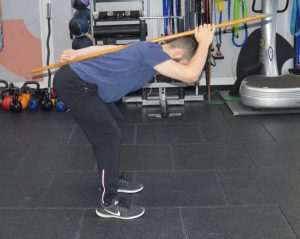The birth of a baby or any lower abdominal surgery compromises core muscle integrity making it crucial for a certified personal trainer to program functional movements aimed at strengthening the deep core. To reduce the risk of injury, core integrity needs to be re-established before incorporating exercises like crunches.
The trauma of abdominal surgery or pregnancy not only directly damages muscle tissue, but also requires healing time, which can cause core musculature to further weaken. Although a normal pregnancy and birth may not cause as much tissue damage as surgery, the experience is a strain on the body and results in lengthened and weakened core muscles.
Since a weakened core may lead to poor stability and muscle imbalances throughout the body, the entire trunk of the body and the muscles that support it will need to be rebalanced and strengthened. This means going back to basics with functional movements that will strengthen the pelvic floor and deep core muscles before advancing to other exercises.
In order to train the core completely, include dynamic stabilization as well as isometric & proprioceptive movements – not just for the mid-section, but for the entire trunk. Training should establish motor control, mobility, and stability as well as develop strength and increase core power.
Re-Establishing Deep Core Integrity
It is important to strengthen the pelvic floor once the lower abdomen has been compromised. This is especially important if a Diastasis Recti is noted. Kegel exercises are a great way to restore deep core integrity. They aren’t just for women who have had babies – they are for any woman who has had any type of lower abdomen trauma. Encourage your client to practice these exercises 2-3 times per day on their own with a goal of achieving 100 contractions a day, in addition to the functional training program you are designing for them.
Establishing Mobility
Another important exercise to strengthen the pelvic floor is a pelvic tilt. Executing a posterior pelvic tilt (or lift) lengthens the lumbar extensors (which can tighten up during pregnancy and is often problematic when the core is weak), strengthens gluteal muscles, rectus abdominus and deep core muscles, and encourages balanced musculature in the hip complex.
The additional weight and length of pregnancy can overstretch and thus weaken the pelvic floor resistance to stretch over time. It can also become weakened after any type of surgical procedure. Performing this exercise routinely can reduce lower back pain, improve posture, and improve bladder control.
Pelvic tilts activate intrinsic core stabilizers so that the proper abdominal muscles are working and overactivity in the low back is reduced.
To perform a pelvic tilt:
- Have the client lay with their back on the floor and knees bent.
- Then instruct her to flatten her back against the floor by tightening the abdominal muscles and rolling the pelvis up slightly.
- Hold for about 10 seconds then repeat for 20 reps.
- An alternative to laying on the floor would be to stand with their back against the wall and have them tighten their abdominal muscles while bending their pelvis upwards.
When improving mobility, it is also important to focus on improving one’s flexibility by ensuring that your client properly stretches. There are many stretches one can do but the hip flexor stretch is among one of the most important. Tight hip flexors contribute to back pain and bad posture.
To perform a hip flexor stretch:
- Have the client lunge with one foot far behind other foot
- Instruct her to keep chest high while bending front knee and straightening rear leg by pushing hips down and forward
- Hold stretch for about 30 seconds then repeat with opposite side
This is one static stretch for the hip flexors but there are many other methods; explore what works best for your client.
Establishing Stability
There are many rehabilitative exercises that will strengthen & stabilize the core. You want to be sure to select safe, functional exercises that will build strength – not potentially cause other injuries to your client.
The following are some examples of core stabilizing exercises. You may need to modify depending on the flexibility & range of motion that your client inhibits.
- Hip Hinge*
- Cat Camel
- Bird Dog
- Glute Bridge
- Heel Slides
- Toe Taps
A hip hinge* is an important exercise when done correctly because it promotes a neutral spine and does not load the lower back as much as squatting. This motion is important to integrate into daily activities since the most likely causes of back pain are repetitive stress caused by improper posture when bending and lifting things. If the client has trouble, just do a partial range and bend knees more.
To perform a hip hinge:
- Stand with feet shoulder width apart and knees slightly bent
- Hold a pole from your head past your tailbone
- Bend from the hips without letting the pole separate from the body
- If pole moves from body the spine is flexing and you’ve gone too far!
Other Considerations for Strengthening Abdominal Muscles after Pregnancy
Be sure to assess and correct postural distortions, faulty motor patterns, and/or balance issues as she relearns the correct motor patterns and basic movements. Once the basics are mastered you can challenge the client further by slowly adding more advanced movements & exercises into their program.
Educate your client on ways to incorporate awareness into everyday activities, such as how she sits. For those who sit all day, the muscles supporting the trunk become imbalanced, as the hip flexors and lumbar extensors shorten and abs aren’t activated.
As a result, our lower back becomes overactive, possibly leading to pain and injury. Instruct your client to always sit upright, with engaged core muscles and maintain good posture throughout the day. Advise them to also take frequent breaks taking an opportunity to stand, walk around, and/or stretch periodically throughout the day.
____________________________________
______________________________
 Gina Stallone is an NFPT-certified personal trainer, fitness nutrition specialist and wellness blogger. She worked in Corporate America and freelanced as a sports reporter over the last 15 years. After losing 80lbs and having struggled with weight & hormonal conditions for most of her life, she decided to become a trainer & nutritionist to help others in their own Fight to be Fit. She currently works as a trainer, teaches weekly bootcamp, and has begun working as a fitness instructor for children with special needs.
Gina Stallone is an NFPT-certified personal trainer, fitness nutrition specialist and wellness blogger. She worked in Corporate America and freelanced as a sports reporter over the last 15 years. After losing 80lbs and having struggled with weight & hormonal conditions for most of her life, she decided to become a trainer & nutritionist to help others in their own Fight to be Fit. She currently works as a trainer, teaches weekly bootcamp, and has begun working as a fitness instructor for children with special needs.
Guest authors offer experience and educational insights based on their specific area of expertise. These authors are contributing writers for the NFPT blog because they have valuable information to share with NFPT-CPTs and the fitness community at-large. If you are interested in contributing to the NFPT blog as a guest, please send us a note expressing your interest and tell us how you can contribute valuable insights to our readers. We look forward to hearing from you! Send to editor@nfpt.com


